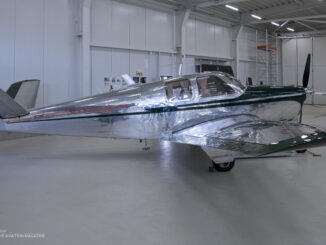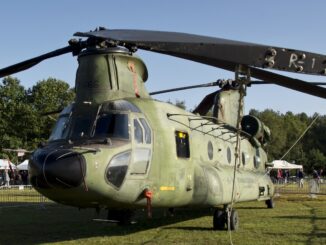 L-60 Brigadýr (c/n 150507, OK-LKN), flying display at XVI. European An-2 Meeting, Hradec Králové, August 2012.
L-60 Brigadýr (c/n 150507, OK-LKN), flying display at XVI. European An-2 Meeting, Hradec Králové, August 2012.
In the early post-war years, the Czechoslovak Air Force still operated utility and liaison aircraft developed by the Nazi Germany. A local copy of the well-known short take-off and landing (STOL) aeroplane Fieseler Fi 156 Storch was still manufactured by aviation plant Orličan in Choceň. The aircraft was designated K-65 Čáp (English: stork) and approximately 140 examples were built until 1949.
However, the K-65 – based on an aeroplane introduced into service in 1936 – quickly became obsolete and needed a successor. As a consequence, in 1951 the Czechoslovak Ministry of Defence opened a competition for new liaison and utility aircraft. That contest was won by project named LB-60 and proposed by engineer Ondřej Němec. Shortly thereafter, a construction team codenamed ´LB´ was established and assigned the task of building prototypes of the new aeroplane.
At that time, large part of the Czechoslovak industry was centralized under the state-owned cooperatives that included also aviation manufacturers, such as Aero Vysočany in Prague and already mentioned Orličan. The development of the LB-60 was initially undergoing in Aero site but soon after was transferred to Choceň. This fact often results in adding either Aero or Orličan to the name of the aircraft, nevertheless at the time the LB-60 was developed, none of them existed as a separate aviation plant.
In the middle of 1953, due to tragic death of Ondřej Němec, work on the new aircraft was entrusted to engineer Zdeněk Rublič and his team. The first prototype, designated XL-60, was ready at the end of 1953.
Initially, the XL-60 had to be powered by Praga Doris engine, also known as Walter M-208, and designed by Jaroslav Kruliš. Works on that engine began already in 1947, in the former Walter engine company – after nationalisation known as Motorlet s.p. – but were significantly delayed. Therefore, Argus As 10C, powerplant used with K-65 aircraft, was quickly adopted for the XL-60 prototype.
The new Czechoslovak utility aircraft took-off for the first time on 24th December 1953. The flight was completed successfully, although some problems with horizontal stabiliser were reported. In addition, it was noted that aircraft was significantly underpowered and therefore Argus engine could not be used in serial manufactured aeroplanes. It was necessary to wait with further development until the middle of the next year, when the Praga Doris engine was ready and the horizontal stabiliser redesigned.
On 22nd March 1955, the second prototype took-off for its maiden flight. It was equipped with a 300-litre tank for chemicals intended for aerial application, thus became the first Czechoslovak factory-fitted agricultural aeroplane (known as L-60B). It was also the time the aircraft received its official designation L-60 Brigadýr (English: brigadier).
In June of 1955, the L-60A liaison and reconnaissance variant of the aircraft, intended for the Czechoslovak armed forces (and designated there as K-60), completed its first flight. It was characterized by even more simplified construction and was armed with one 7,92 mm machine gun as well as two bomb racks.
Serial production of the L-60 was launched in 1956 but lasted only three years. Manufacturing of Brigadýr was ceased in 1959 after completing 273 examples of the aircraft. Most of the aeroplanes were acquired by the Czechoslovak armed forces and Agrolet state-owned company that provided the aerial application services. Nevertheless, some aeroplanes were also used for towing gliders in aeroclubs or air ambulance. A few examples were sold to other Eastern Bloc countries.
The Czech armed forces operated the K-60 aeroplanes until 1968. Approximately at the same time, Agrolet replaced their L-60A with Z-37A Čmelák crop duster aircraft. Nevertheless, some number of the L-60s is still used in aeroclubs and by private operators as glider tug and sightseeing aircraft.
Regrettably, the Praga Doris was unreliable powerplant, causing several problems during everyday operations of Brigadýr aircraft. Therefore, majority of the L-60s underwent engine upgrades, for example by replacing original powerplant with Ivchenko AI-14RA radial engine.
Nowadays, there are reportedly only two airworthy L-60 aeroplanes still powered by the original Praga Doris engine. The OK-LKN aircraft spotted at XVI. European An-2 Meeting in Hradec Králové back in 2012 – featured in our current Photo of the Week – is exactly one of them.



